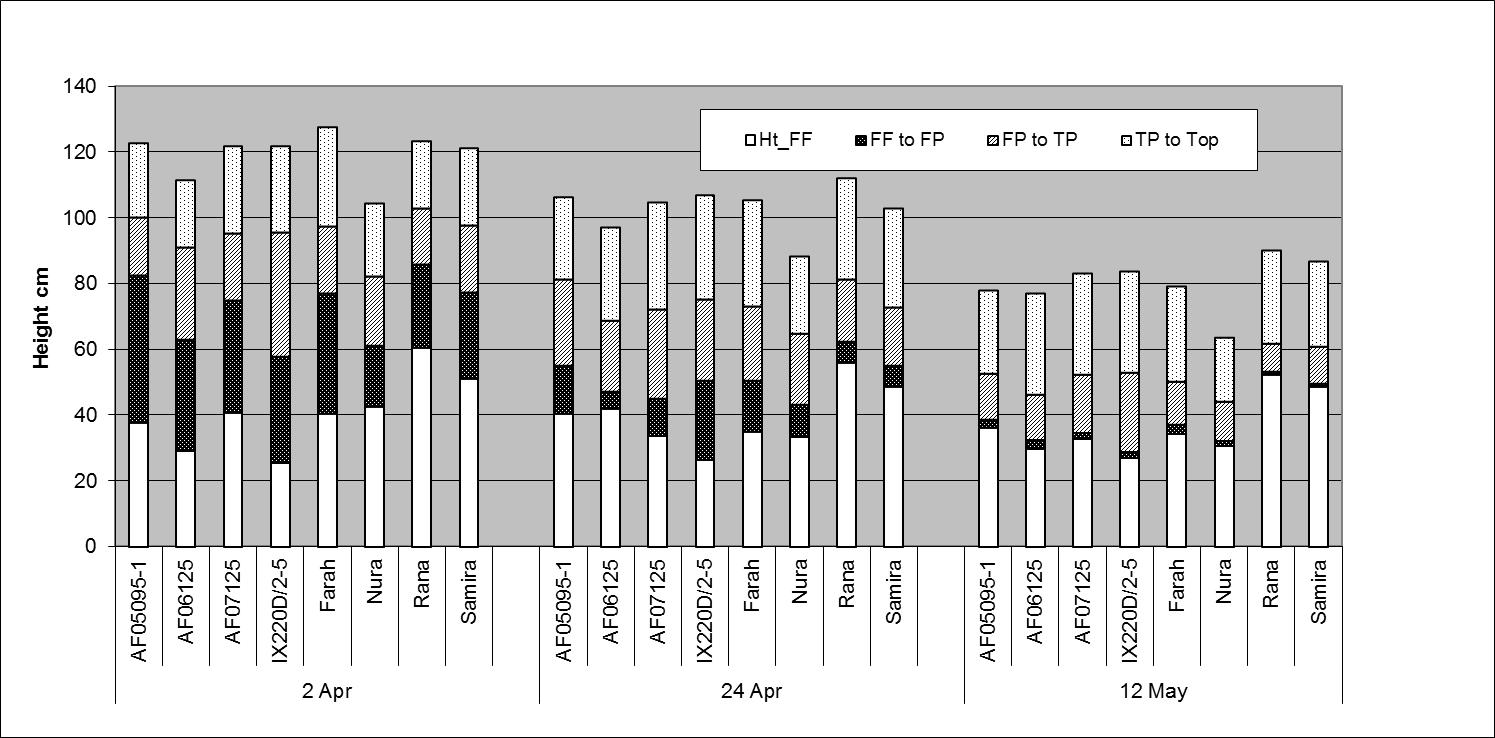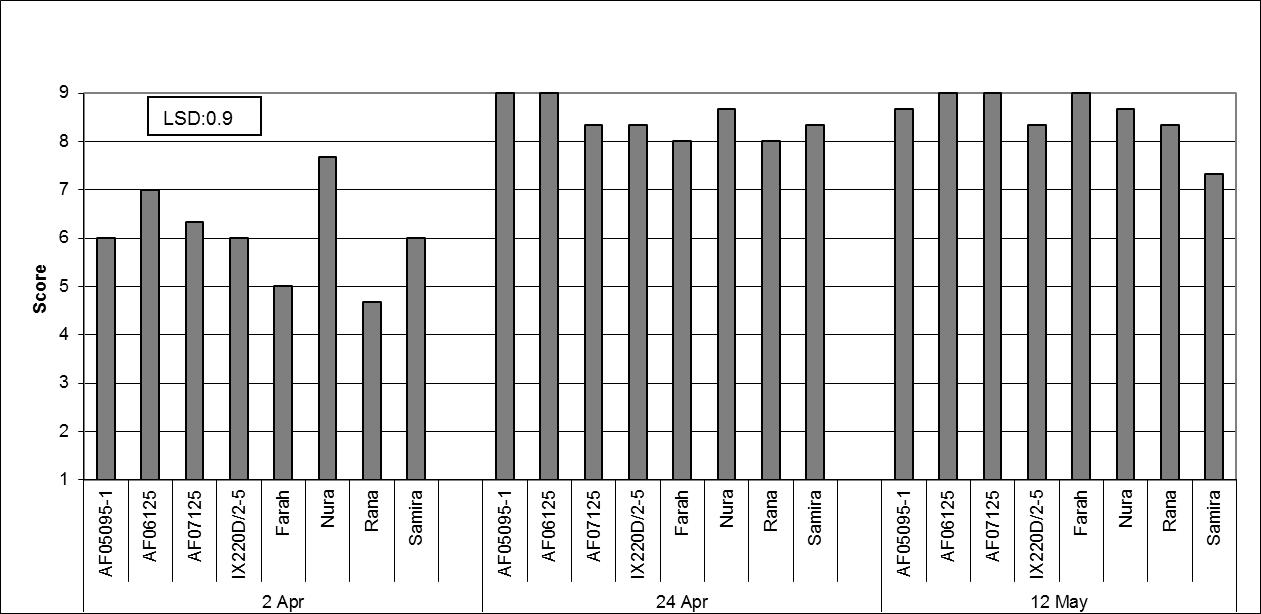Faba beans for acidic soils in southern NSW - yields and time of sowing effects
Author: Eric Armstrong, Luke Gaynor, Gerard O’Connor, Sarah Ellis and Neil Coombes (NSW DPI, Wagga Wagga Agricultural Institute) | Date: 28 Jul 2015
Take home messages
- Sow faba bean from 20 April to 15 May on acidic soils of southern NSW.
- Sowing earlier than the above dates can result in excessive lodging and disease risk.
- Sowing later lowers yield and produces shorter plants affecting harvestability.
- Choice of sowing time is far more important than choice of variety.
Background
Variety evaluation and agronomic investigations with faba bean have been undertaken at Wagga Wagga Agricultural Institute as part of a national team program focusing on both faba bean agronomy (GRDC DAV00113 – Expanding the use of pulses in the southern region) and breeding (GRDC UA00127 - Pulse Breeding Australia).
The crop is showing considerable promise as both a profitable crop in its own right and as a pulse break crop in southern NSW cropping sequences. It is a competitive, erect, vigorous crop with high dry matter production and grain yield potential. Faba bean appears slightly more frost hardy and more tolerant of heavy soils than other pulses, fixes large amounts of nitrogen, has non-shattering pods and is well suited to mechanical harvest. It is important to adhere to tight disease protocols across the entire season, and not to sow the crop too early which promotes disease, excess growth and lodging (particularly in favourable extended springs), nor too late depriving the crop of height, bulk and yield (especially in drier seasons with quick early springs).
This article reports on a variety by sowing time trial conducted at Wagga Wagga in southern NSW in 2014 on an acidic red brown duplex soil.
Our research interest was focused on the recommended sowing window (April / early May) and not post mid-May, which we already know pushes flowering and grain fill into rising spring temperatures and moisture stress, and consequently restricts the crop’s performance, plant height, dry matter (DM) production and grain yield.
Methodology
Eight varieties/breeding lines were included in this experiment but for simplicity and clarity, only four commercial varieties and one breeding line are reported here. Three sowing times were undertaken; 2 April, 24 April and 12 May. Stubble was absent and plots direct-drilled using a six-row cone seeder with 300mm row spacing and GPS guidance. At seeding, 80kg/ha SuPerfect Grain Legume Super (NPKS 0:13.8:0:6.1) was placed approximately 2cm below the seed. Group F peat inoculant was mixed with water in an on-board tank and injected down each sowing tine at sowing. Normal recommended cultural practices were adopted for weed, insect and disease control throughout the season.
Soils
The site was a cropping paddock which was limed in 2011 lifting the pH to 5.2 at 0-10cm depth (see Table 1), providing a more favourable environment for pulses and their associated rhizobia. The paddock had a failed pasture in 2013 and was chemically fallowed in the spring, which provided some benefits to this seasons pulse trials.
Table 1. Soil analysis paddock 20A Wagga Wagga Agricultural Institute 2014.
| Depth | pH (CaCl2) | Al Sat % | Nitrate N | Ammonium N | P (Colwell) | CEC |
|---|---|---|---|---|---|---|
| 0-10cm | 5.2 | 1.7 | 8.5 | 0.8 | 34 | 7.0 |
| 10-20cm | 5.0 | 2.5 | 15 | 1.1 | 13 | 6.5 |
Season effects
Chocolate spot (Botrytis sp.) fungal disease was present in the crops especially the early times of sowing but did not become severe. Fungal disease requires moist conditions, with 90 per cent relative humidity optimal for disease spread, and was held in check by the dry weather in the spring. The high incidence of frosts through July and August caused stem splitting and bending that was most severe in the early sown crops. Overall, 2014 was a favourable pulse year at Wagga Wagga with minimal disease, above average yields and an early dry harvest producing good quality unblemished seed.
Results and discussion
Grain yield, dry matter production and harvest index (HI%)
Grain yields were between 2.8 and 3.1 t/ha, well above the expected long term average of 1.8-2.0 t/ha for faba beans at Wagga Wagga. This result was remarkable given the very dry warm July, August, September and October and the 2-3 weeks premature finish to the growing season.
Despite these good yields, differences between varieties and sowing times were not statistically significant, suggesting the dry spring created a levelling affect across all treatments, with moisture and temperature imposing a ceiling to potential yield. All treatments effectively ran out of moisture. These results support a sowing time window from early April to mid May for faba bean. At this site based just north of Wagga Wagga, growers still need to be mindful of the pitfalls of sowing too early (prior to 15 April - excessive height, lodging and disease) and sowing too late (short plants, loss of DM and grain yield).
Dry matter production was similar at the first two sowings (9.1-9.3 t/ha) but fell significantly (20%) from the delayed sowing to 12 May (average 7.4 t/ha). Overall there was a significant effect of variety on DM production (Table 2). Nura , a shorter stemmed plant type had the least biomass and AFO5095-1 the most DM at peak biomass.
Harvest Index (HI%) was similar at the first two sowings (31-32%) but rose significantly at the final sowing (38%). Dry matter is converted more efficiently into grain yield with later sowings, but the down side to this is that there is likely to be less residual fixed N since a greater proportion of N is exported in the grain.
Table 2: Plant density, grain yield and peak dry matter production.
| Variety | plants /m2 | Grain yield t/ha | Dry matter t/ha |
|---|---|---|---|
| AF05095-1 | 41 | 3.02 | 9.16 a |
| AF06125 | 48 | 2.91 | 8.2 c |
| AF07125 | 38 | 2.71 | 8.56 bc |
| IX220D/2-5 | 42 | 2.77 | 8.39 bc |
| FarahA | 38 | 2.86 | 8.54 bc |
| NuraA | 44 | 2.81 | 8.18 c |
| PBA RanaA | 51 | 2.82 | 8.96 ab |
| PBA SamiraA | 47 | 3.03 | 8.98 ab |
| P value | <0.001 | 0.08 | 0.006 |
| LSD | 3.9 | ns | 0.58 |
Plant Height and Podding
Varieties such as PBA Rana that flower and pod later tend to set pods on later nodes, higher up the stem than early varieties such as IX220D/2-5 (Figure 1). Plant height and height of bottom pods declined significantly with delayed sowing from 2 April to 12 May. Past experience shows this trend continues with further sowing delays. This has a significant effect on the harvester’s ability to get below bottom pods and for this reason farmers should not delay sowing.
In contrast plants can grow too tall and lodge when sown too early, as occurred in this experiment at the first (2 April) sowing (Figure2). PBA Rana and Farah were most vulnerable to lodging under ideal early growing conditions. All varieties were shorter at the second and third sowings and remained erect, simplifying management and harvest.

Figure 1: Effect of sowing date and variety of faba bean on height of the stem to first flower (FF), first pod (FP), top pod (TP) and to the top of the plant (Top).

Figure 2: Effect of sowing date and variety on plant lodging of faba bean. The scale for erectness below uses a 1-9 score, where 9 is completely vertical; and 1 completely flat.
Growth and development phases
Delay in sowing constricts the flowering and grain fill phases of all faba bean varieties. For example, a 40 day difference at sowing (from 2 April to 12 May) was reduced on average to only a 12 day difference between varieties at the end flowering (range 17 September to 29 September), and further to only four days difference at maturity (range 27 October to 31 October) (Figure3).
This significant reduction of the growing period with later sowings was reflected in much shorter plants, more erect growth, less disease, reduced DM, a halving of the length of the flowering period (from 73 days to 37 days) and a significant reduction in the number of flowering nodes. Interestingly, yield remained unaffected, reflecting a great plasticity of faba bean plant to adjust its growth and development with changes in environment. Nura was the latest variety to flower at all sowing dates, preceded by PBA Rana and PBA Samira.
IX220D/2-5 is a very early northern NSW breeding line and was included in this trial to compare phenology to southern lines. It started flowering 60, 37 and 18 days earlier than PBA Rana at the 1st, 2nd and 3rd sowing respectively, but finished flowering only 6-8 days earlier. This wide, flowering window results in a significantly larger number of podding nodes to potentially contribute to yield, and some insurance against environmental extremes during this period. It demonstrated a very high yield potential in 2013, but this advantage did not carry through to 2014.

Figure 3: Development phases of faba bean varieties at three sowing dates at Wagga Wagga in 2014.
Conclusion
Faba beans had above average yield (2.8 -3.1 t/ha) in a dry spring at Wagga Wagga.
Early April sown high bulk treatments, escaped a yield penalty from potential diseases due to the dry spring. If an average spring occurs, disease in the early sown treatments would be difficult to control with fungicides.
The dry spring largely negated differences between varieties and time of sowing as yield potential was not reached.
Contact details
Sarah Ellis
sarah.ellis@dpi.nsw.gov.au
Was this page helpful?
YOUR FEEDBACK
